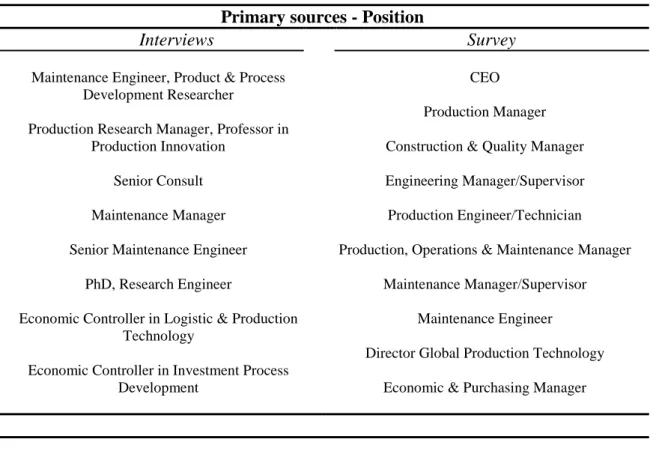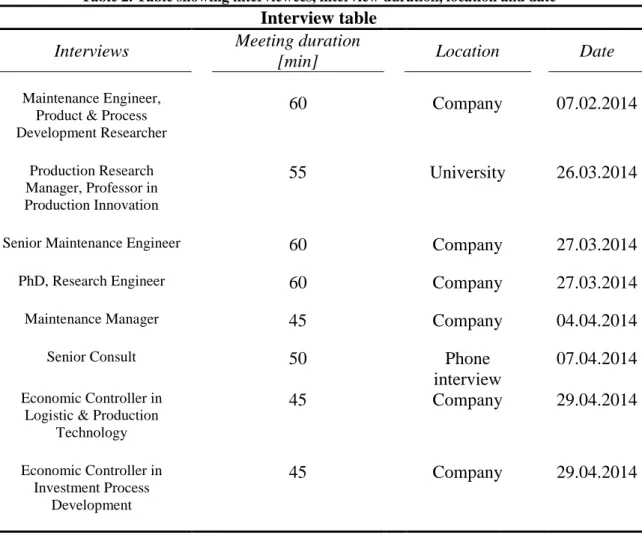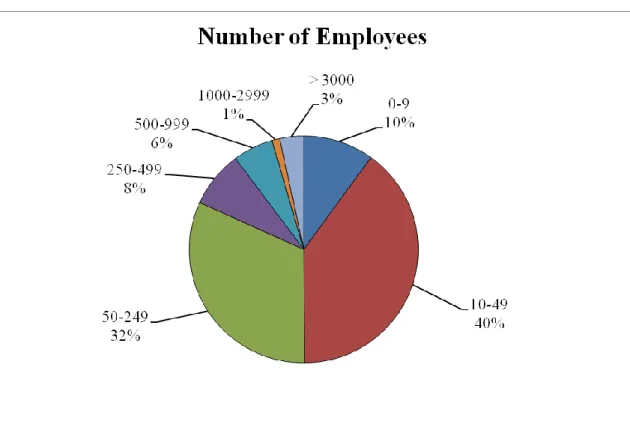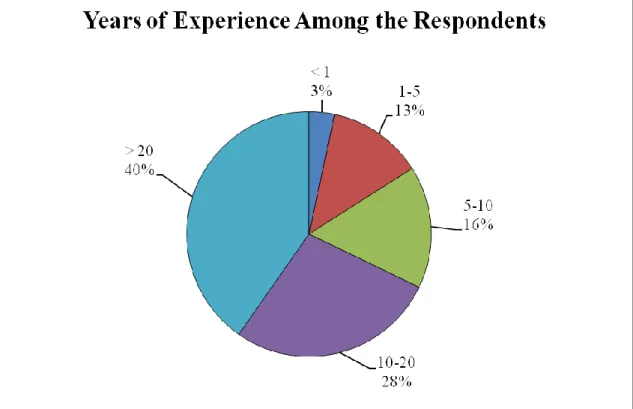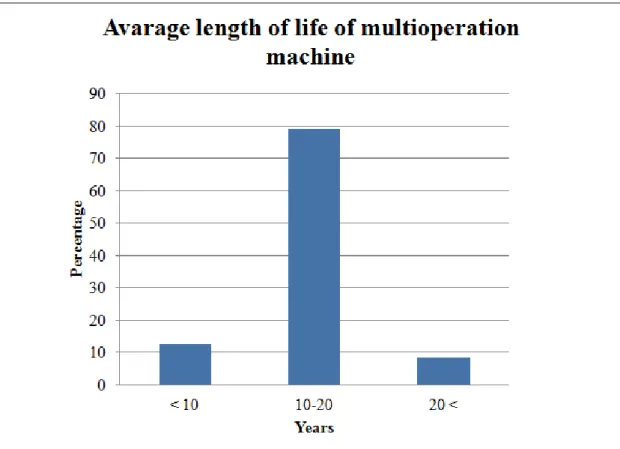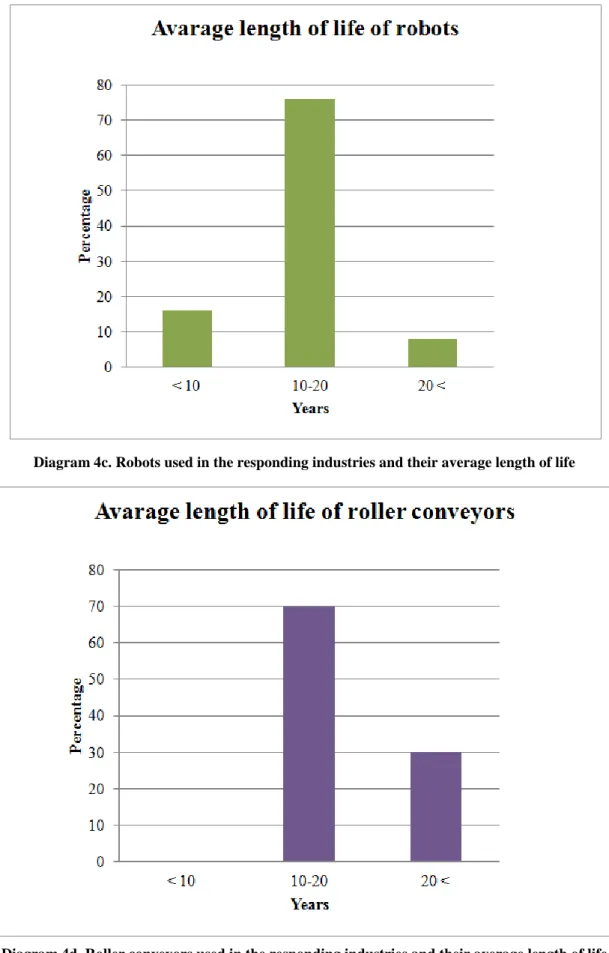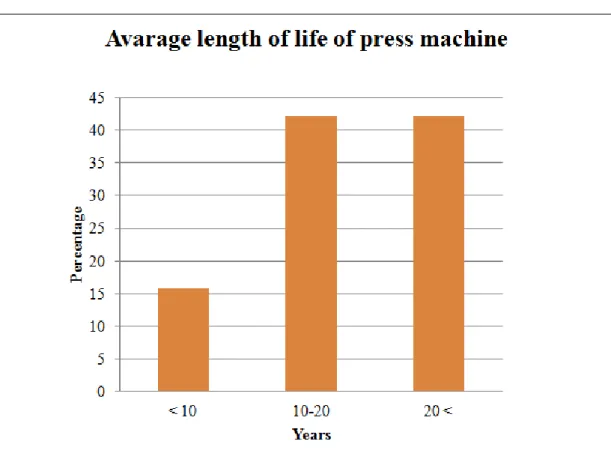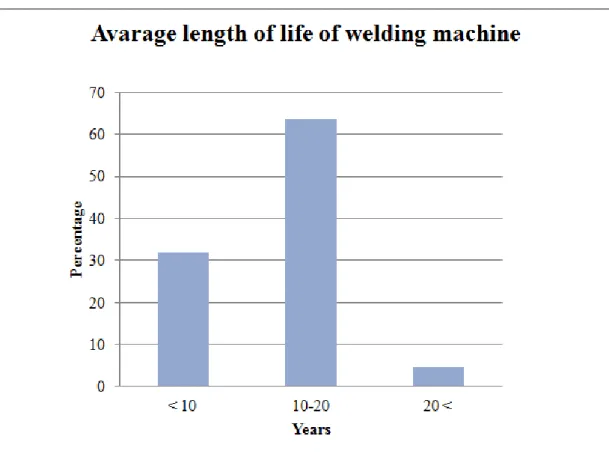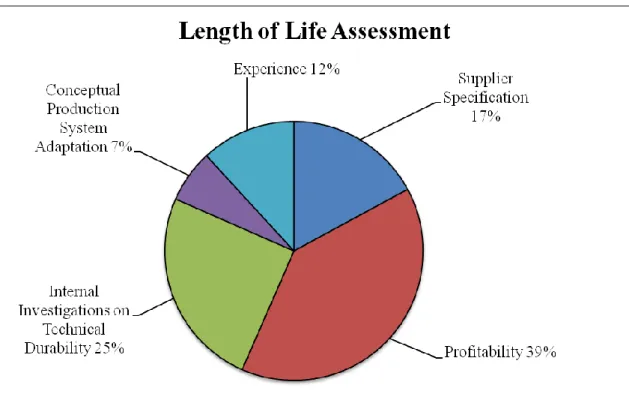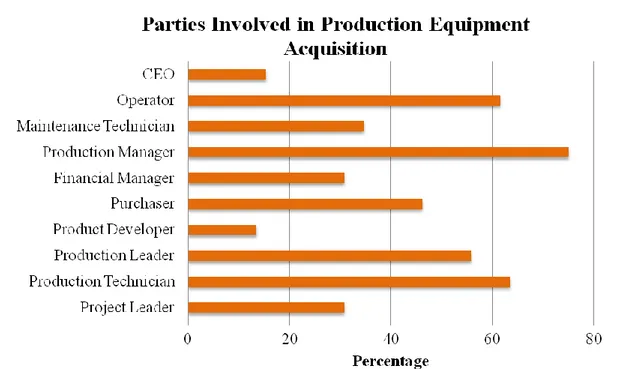Akademin för Innovation, Design och Teknik
Differences in Lengths of Life of
Production Equipment & Production
Systems and their implications on
Acquisition & Replacement Processes
Master thesis work
Advanced level, 30 credits
Product and process development Production and Logistics
Aria Karim
Anna Schnelzer
Report nr:
Tutor (industry and university): Jessica Bruch, Antti Salonen Examiner: Sabah Audo
ABSTRACT
Nowadays usage of advanced production equipment becomes more common among production industries, future challenges in the market require flexibility in production industries due to growing competition and demand responses. Decisions regarding acquisition and replacement of production equipment have a major role in future profitability and competitiveness of production industries. Production equipment life cycle is dependent on technical, economical and conceptual lengths of life. Technical and economical lengths of life are connected to production equipment and the conceptual length of life is connected to production systems.
Acquisition and replacement assessment processes of production equipment within production industries require involvement from different responsible departments. Varieties of perspectives differ from different departments in their prioritization regarding economical, technical and conceptual lengths of life. Lack of collaboration and evaluation of critical factors create quality and capacity issues in production industries. This project is directed to investigate issues concerning establishment of a sustainable long term thinking in consideration of economical, technical lengths of life of production equipment and also conceptual length of life of production systems in an earlier stage of acquisition and replacement assessment processes.
Investigated research questions in this project are the following; What is the correlation between lengths of life of production equipment & production systems and how they influence each other? What is the basis for acquisition and replacement assessment of production equipment? How does buyer-supplier relationship influence length of life of production equipment? This thesis work is based on both theoretical and empirical findings. A case study was performed with a survey and interviews to gather data for the analysis.
Technical and conceptual lengths of life are both based on economical profitability and have to be adapted to product generations. Expensive investments in production equipment are critical and can be risky for production industries if marketing experts are excluded or if future product generation forecast are not considered in production equipment acquisition processes. Information and knowledge inputs from production equipment suppliers have to be considered in an earlier stage of concept development in production systems.
SAMMANFATTNING
Nuförtiden blir användandet av avancerade produktionsutrustningar allt vanligare inom produktionsindustrin, framtida utmaningar i marknaden kräver flexibilitet inom produktionsindustrin på grund av växande konkurrens och respons på efterfrågan. Beslut gällande anskaffning och utbyte av produktionsutrustningar spelar en stor roll i produktionsindustrins framtida lönsamheter och konkurrenskraftighet. Produktions-utrustningars livscykel är beroende av teknisk, ekonomisk och konceptuell livslängd. De tekniska och ekonomiska livslängderna är kopplade till produktionsutrustningar medan den konceptuella livslängden är kopplad till produktionssystemet.
Bedömningsprocessen vid anskaffning och utbyte av produktionsutrustningar inom produktionsindustrin kräver delaktighet från olika ansvariga avdelningar. Perspektiv variationer och prioriteringar gällande ekonomisk, teknisk och konceptuell livslängd skiljer sig mellan olika avdelningarna. I brist på samarbete och utvärderingar av kritiska faktorer skapas kvalitets- och kapacitetsproblem inom produktionsindustrin. Detta projekt utreder problem gällande etablering av ett hållbart och långsiktigt tänkande med hänsyn till ekonomisk och teknisk livslängd av produktionsutrustningar samt konceptuell livslängd av produktionssystemet i ett tidigare skede av bedömnings-processen.
Följande forskningsfrågor har undersökts i detta projekt: Vilken effekt har olika livslängder på produktionsutrustningar samt produktionssystemet, och vad har de för koppling? Vad är grunden för anskaffnings- och utbytesbedömningar av produktions-utrustningar? Hur inverkar relationen mellan köpare och leverantörer på livslängden av produktionsutrustningar? Detta examensarbete är baserat på både teoretiska och empiriska undersökningar. En fallstudie genomfördes med en enkät och intervjuer för att samla in data till analysen och besvara forskningsfrågorna.
Den tekniska och konceptuella livslängden är båda baserande på ekonomisk lönsamhet och måste anpassas till produktgenerationer. Dyra inverteringar i produktions-utrustningar är kritiska och kan vara riskabla för produktionsindustrin om marknads-experter är uteslutna eller om framtida produktgenerations prognoser inte beaktades i anskaffningsprocessen. Information och kunskap från leverantörer av utrustningar måste beaktas i ett tidigt skede vid konceptutveckling inom produktions-system.
ACKNOWLEDGEMENTS
The authors of this thesis project would like to thank all interviewees and survey respondents that have contributed and shared their knowledge and experiences from different production industries. Special thanks to Jessica Bruch and Antti Salonen for guidance and constructive criticisms of our thesis work.
CONTENTS
1. INTRODUCTION ... 10
1.1. BACKGROUND ... 10
1.2. PROBLEM FORMULATION ... 11
1.3. AIM AND RESEARCH QUESTIONS ... 11
1.4. DELIMITATIONS ... 12
2. RESEARCH METHODOLOGY ... 13
2.1. SURVEY RESEARCH ... 13
2.2. CASE STUDY RESEARCH ... 13
2.3. DATA COLLECTION ... 14
2.4. QUALITATIVE DATA ANALYSIS ... 14
2.5. SEMI-STRUCTURED INTERVIEWING ... 14
2.6. LITERATURE REVIEW ... 14
2.7. PRIMARY DATA COLLECTION ... 15
3. THEORETICAL FRAMEWORK ... 19
3.1. TECHNICAL LENGTH OF LIFE ... 19
3.2. CONCEPTUAL LENGTH OF LIFE ... 22
3.3. ECONOMICAL LENGTH OF LIFE ... 24
3.4. BUYER-SUPPLIER COLLABORATION ... 26
4. EMPIRICAL FINDINGS ... 27
4.1. RESULTS FROM THE SURVEY ... 27
4.2. RESULTS FROM INTERVIEWS ... 36
5. ANALYSIS ... 40
5.1. SURVEY ANALYSIS... 40
5.2. RESEARCH QUESTIONS ... 40
6. DISCUSSION AND CONSLUSIONS ... 44
7. REFERENCES ... 48
LIST OF DIAGRAMS
Diagram 1. Number of employees among the responding industries ... 24 Diagram 2. Turnover distribution in million SEK ... 25 Diagram 3. Years of experience among the respondents in their industries ... 25 Diagram 4a. Multioperation machine used in the responding industries and their
average length of life... 29 Diagram 4b. Processing machine used in the responding industries and their
average length of life... 29 Diagram 4c. Robots used in the responding industries and their average length of
life... 30 Diagram 4d. Roller conveyors used in the responding industries and their average
length of life... 30 Diagram 4e. Hardening plant used in the responding industries and their average
length of life... 31 Diagram 4f. Press machine used in the responding industries and their average
length of life... 31 Diagram 4g. Welding machine used in the responding industries and their average
length of life... 32 Diagram 5. Different factors and their impacts on production equipment length of
life which have been ranked by the respondents... 32 Diagram 6. Assessment on length of life distribution among the respondents ... 33 Diagram 7. Involvers in production equipment acquisitions among the responding
industries ... 34 Diagram 8. Level of impacts on production equipment replacement which have
been ranked by the respondents ... 34 Diagram 9. Economic length of life timeframe estimation ... 35
LIST OF TABLES
Table 1. Primary sources for the interviews and the survey ... 15 Table 2. Table showing interviewees, interview duration, location and date ... 18 Table 3. The SNI-codes and their respective industries ... 52
LIST OF FIGURES
Figure 1. Involved parties in acquisition and replacement processes of production equipment and involvement of other preferable parties such as marketing and product developers... 44 Figure 2. Factors that influence production equipment functionality and
operability... 45 Figure 3. Length of life triangle shows differences between long and short term
ABBREVIATIONS
LCAMP Life Cycle Asset Management Plan
LCC Life Cycle Cost
LCCA Life Cycle Cost Analysis
1. INTRODUCTION
Production industries are using more and more cutting edge and advanced production equipment to cope with competitive and changeable markets. There is a need to clarify and investigate assessment processes of production equipment in industries to decrease misunderstandings and conflicts. Internal conflicts among different departments are common related to acquisition and replacement assessment processes of production equipment. The following headings will give a background showing the importance of this research area and introduce the problem formulation, aim and research questions investigated in this thesis work.
1.1. Background
A key source for superior production capabilities is how to perform the design of production system and acquisition & replacement assessment processes of production equipment in a sustainable perspective. Production equipment represent a large concentration of resources in production. Decisions regarding their repair and replacement have a major role in future profitability and competitiveness of production systems (Mathew and Kennedy, 2003). Maintenance problems of production equipment are occasionally results of lack in production equipment design and it’s primarily created by production equipment suppliers. However it’s often part of maintenance department´s responsibility (Kelly, 2006). According to Aurich et al. (2006) product related services such as maintenance, retrofitting and user trainings represents 18% of the total turnover of the German discrete part production industry.
To cope with today's competition, production industries need to focus on the design and assessment processes of production systems. Production systems need to be able to handle changes in volume, products and have quick responses to those changes (Rösiö, 2012). Production industries are typically interested in obtaining cutting edge technology that will last and be competitive for a long time period. This is also one way to improve production performance by investing in new production equipment (Lager and Frishammar, 2010). Investment evaluation procedure requires a combination of both strategic and financial methods that consider long term thinking and strategic position of industries related to technology advancement, product quality, plant modernization and competitiveness (Oeltjenburns et al., 1995).
Production equipment need to be chosen based on the functionality throughout their entire life cycle. Based on results from earlier researches, it shows that there are differences in technical, economical and conceptual lengths of life. Conceptual length of life of production systems is often longer than technical and economical lengths of life of production equipment (Bellgran and Säfsten, 2010).
1.2. Problem Formulation
The idea of this thesis project is to increase awareness of acquisition and replacement assessment processes of production equipment and how different responsible departments collaborate and evaluate several criteria connected to different lengths of life of production equipment and production systems. There is a need to clarify and analyze how different factors affect economical & technical lengths of life of production equipment and conceptual length of life of production systems.
In production industries, varieties of perspectives differ from different departments in their prioritization. Economical departments mostly prioritize economical length of life and forget about technical length of life and the other way around for technical departments. Linkage weaknesses between different departments can have major affects on production such as quality and capacity issues.
New products and product generations can create internal problems that often result in redesign of production systems and could also result in production equipment replacement (Bellgran and Säfsten, 2010). Intensity of technology development of production equipment is also another factor which affects the optimal lifetime and replacement processes of production equipment (Hritonenko and Yatsenko, 2007). Evaluations of existing production systems have a significant factor in acquisition of new production systems. There is a lack of time and knowledge for the evaluations, which affects development, quality and functionality of production systems (Bellgran and Säfsten, 2010). However this project is more directed to investigate issues concerning establishment of a sustainable long term thinking in consideration of economical, technical lengths of life of production equipment and also conceptual length of life of production systems in an earlier stage of acquisition and replacement assessment processes.
1.3. Aim and Research Questions
The purpose of this project is to critically review economical, technical lengths of life of production equipment, conceptual length of life of production systems and analyze its implications on production equipment assessment processes.
RQ1: What is the correlation between lengths of life of production equipment & production systems and how they influence each other?
RQ2: What is the basis for acquisition and replacement assessment of production equipment?
RQ3: How does buyer-supplier relationship influence length of life of production equipment?
1.4. Delimitations
The delimitations in this project are the following:
Production equipment will not be investigated as cells or lines where there are a number of cooperating machines
The interviews and the survey will not include production equipment suppliers
Production equipment below 200.000 SEK will not be considered
Production equipment which are not representative as a part of the core production are excluded
Suggestions regarding methods and tools will not be presented
2. RESEARCH METHODOLOGY
This thesis work is based on both theoretical and empirical findings. The theoretical findings served as a base for the problem formulation, the survey and the questions for the semi-structured interviews. A case study was performed with a survey and interviews to gather data for the analysis to answer the research questions. Different methods and techniques have been used to reach the aim of the project.
2.1. Survey research
Survey research involves primary data in order to determine distribution, incidence and interrelationships within a certain population. In a survey research the data could be gathered by observation techniques, interviews and questionnaires. Surveys have been widely used in information management and information systems research (Williamson, 2002).
In this case it’s preferable to use a descriptive survey (status quo) to investigate current situation, properties and conditions instead of an explanatory survey which is more analytically and numerically based. According to (Tanner, 2002) transmitted data in electronic form as Email surveys are much more flexible and greatly facilitates the process of data collection, data capturing and data analysis, compared to print based forms. By experiences web surveys share many advantages, for example targeting a wide and geographically dispersed audience very fast, higher response rate, low cost and complete transcript of all responses is electronically captured (Williamson, 2002).
2.2. Case study research
Case study research has been used intensively in social sciences as a manner to develop an understanding of phenomena in their natural setting and it’s most concerned primarily with qualitative data. Especially when existing knowledge is limited, case study research is useful to provide evidence for exploration and hypothesis generation and it shares characteristics related research strategies which also involves analysis and collection of empirical evidence (Cavaye, 1996; Darke and Shanks, 2002). Case study research is the most widely used qualitative research method within information systems research community and it can also be combined with other research method as survey research method (Gable, 1994; Orlikowski and Braoudi, 1991). According to (Yin, 1994), a case study is:
“An empirical enquiry that investigates a contemporary phenomenon within its real-life context, especially when the boundaries between phenomenon and context are not clearly evident”
This type of research is particularly appropriate for situations when understanding and examination of a specific context is important in a particular research area of interest. There are situations where terminology, a common set and language of definitions are not yet clear or widely accepted. It could also be the scope of understanding of how and why processes or phenomena occur, where theory and research are at early formative stages or where the experiences are critical (Darke and Shanks, 2002).
2.3. Data collection
The data collection in case study research can be difficult, time consuming and requires careful planning, researchers should prepare sufficient information related to the case study before the data collection procedure ((Darke and Shanks, 2002; Yin, 1994). Collecting data could be primary data or secondary data, which researchers base their research and conclusions on (Darke and Shanks, 2002).
2.4. Qualitative data analysis
Qualitative data analysis is the way which researchers can communicate their findings to others articles, reports and books, in most cases theorization is based on qualitative data analysis and interpretation of that analysis is very important (Williamson and Bow, 2002). Qualitative analysis defines as a “Working up” process from collected data and its associated with grounded theory, researchers are primarily interested to ensure that their developed theory is well grounded in the collected data (Richards and Richards, 1998).
2.5. Semi-structured Interviewing
Interviewing is mostly seen as a technique to collect qualitative data. It’s usually used in case studies and surveys as supplement, especially when information and questionnaire are complicated. Interviewing technique allows understanding people from their own point of view and it’s often easier to obtain a higher response. In semi-structured interviews a list of questions is supporting the conversation and participants are allowed to generate questions based on discussions, which is useful to explore a specific subject (Williamson, 2002).
2.6. Literature Review
In this case the literature review introduces three different lengths of life of production equipment and production systems. Production impacts on different lengths of life are presented as well as their different impacts on the production. The review also addresses implications of repair and replacement of production equipment and development of long term functioning production systems. The findings strongly suggest that the industries are highly dependent on their production equipment suppliers and many problems occur during their collaboration. Therefore one of the parts in the review concentrates on the buyer-supplier collaboration and the conflicts generated during production equipment acquisition and replacement processes.
The Literature review includes literature from books, articles in scientific journals and conferences. The literature covers a broad range of facts such as maintenance, life cycle assessment management, production & operation management, production development, system life cycle, advanced production technology, optimal equipment replacement, life cycle of equipment, length of life of equipment, production equipment acquisition, production system design and buyer-supplier collaboration. The articles and conferences are collected from these different databases; DiVA, Google Scholar, EBSCO Discovery Service and Science Direct. The literature covers a timeframe from 1986 to 2013 and has been sorted out due to their relevance to the subject of this project, research questions, aim and project delimitations.
2.7. Primary Data Collection
The data collection is based on the literature review and a case study. The case study consists of interviews and a survey. To get more competent knowledge in this subject primary sources where selected based on their knowledge and involvement within the problem area. The primary sources chosen in this case study is shown in table 1 below for the interviews and the survey.
Table 1. Primary sources for interviews and survey
Primary sources - Position
Interviews Survey
Maintenance Engineer, Product & Process Development Researcher
CEO
Production Manager Production Research Manager, Professor in
Production Innovation Construction & Quality Manager
Senior Consult Engineering Manager/Supervisor
Maintenance Manager Production Engineer/Technician
Senior Maintenance Engineer Production, Operations & Maintenance Manager
PhD, Research Engineer Maintenance Manager/Supervisor
Economic Controller in Logistic & Production Technology
Economic Controller in Investment Process Development
Maintenance Engineer
Director Global Production Technology
Economic & Purchasing Manager
The research questions and the literature review served as a base when constructing the survey questions, which were divided into two parts. The first part was more directed to introduction questions to gather information about industry sizes, turnover and respondents’ positions. This part was constructed to see differences in industry sizes and to estimate the respondents knowledge based on their positions.
The second part contains definitions and explanations about different terms used in the survey which may not be commonly used in industries, i.e. technical, conceptual and economical lengths of life. The questions are more directed to the subject in this part and categorized depending on their context. Brace (2008) writes that a survey should be well structured and have a logical flow from one subject to another.
The questions were constructed as single-choice, multi-choice, ranking and open-ended questions. Open-ended questions can provide fuller responses and more qualitative data, however open-ended questions increase the time consumption significantly (Brace, 2008; Couper et al., 2001). To reduce time consumption and gather more quantitative data as well as qualitative data, different type of questions were used in the survey and applied to different questions depending on needed data for the analysis.
To increase response quality and to verify that the respondents understood the questions, a first version of the survey was sent to a test group consisting of several project leaders and production developers. The test group measured time consumption and gave feedback on the question formulations and their overall perception of the survey. Results from the test group were analyzed and taken in consideration when reformulating the survey with new ideas. To increase number of respondents and to facilitate the analysis of the results, the survey was constructed in Swedish and transformed into a web based survey, see appendix B for the completed survey.
The completed web survey was sent out to chosen positions in different industries. The industries selected were Swedish production industries within following SNI-codes 25 to 30, the codes represents different categories of production industries shown in table 2 in appendix A. Responses from the survey were collected and compiled for the analysis. Different questions requiring further discussions and more elaborated answers were collected from research questions, survey and literature review. The questions were compiled into a semi-structured interview, which was selected to allow more detailed questions in areas where the interviewees had more specific knowledge.
Different production industries were contacted to gather interviewees with right knowledge in the subject area for the interviews. Interview meetings as well as telephone interview were later booked in different industries and some questions were modified depending on interviewees’ positions. The questions were divided into two main categories; questions for the economists and questions for the interviewees with more specific production knowledge. All question used in this study can be found below. Note that some of the questions are connected to a previous question.
Questions for the economists:
What is your position in the company?
How is the acquisition process performed of new production equipment?
Which parties are involved in the acquisition process of new production equipment? Are there any other parties that are considered important?
What role has the economic manager in the acquisition process?
Is it technical or economical length of life that is prioritized in the acquisition process of new production equipment?
What is the basis for the economical length of life?
How much are the technical length of life and the quality considered during the acquisition process?
Have you implemented any useful/developed acquisition method?
Are you experiencing any issues/difficulties regarding acquisition of new production equipment?
Do these issues/difficulties occur due to suppliers or more internally?
How much do internal opinions affect the final outcome compared to the price?
Who makes the final decision regarding which production equipment to acquire?
If the production equipment does not deliver as the supplier promised, do you feel that you get most of the blame?
How much knowledge do you have regarding production equipment?
In which stage of the acquisition process are you involved?
Questions for the production responsible and the others:
How important are the design process in investment projects where new production equipment are acquired?
How much does the conceptual design of the production system correspond to the actual system?
What triggers a new investment of production equipment or redevelopment of production system?
Can you see any connection between these three length of life; technical, conceptual and economical?
Which parts of the length of life are connected to each other during the assessment of acquiring new equipment? Do you only consider the technical and economical length of life?
Is it the technical or economical length of life that is mostly prioritized when acquiring new production equipment?
Which problems are generated from the different lengths of life?
Which length of life generates most problems?
Which length of life is mostly prioritized?
Is there any developed method regarding the problematic with different lengths of life, and how should they be involved in the acquisition assessment of new production equipment?
Are different product generations considered when acquiring new production equipment or other future factors that are considered important (e.g. capacity, environmental impacts, reconstruction)?
Which factors often influence the length of life of production equipment?
When performing a greater renovation of production equipment and extending the technical length of life, will the economical length of life automatically extend as well or are there exceptions?
How does the lack of knowledge influence the length of life of production equipment?
What does the efficiency trend look like during the length of life?
What parties are involved in the acquisition process of new production equipment and are there other parties that are considered to be important?
In what way are the suppliers involved in the acquisition process of new production equipment?
How much does the actual length of life correspond to what the supplier have promised if you follow their recommendations?
What dilemmas are there in the collaboration between suppliers and customers? What dilemmas have you experienced?
The interview duration was estimated to one hour. More specific interview durations, locations and dates for each of the interviewees can be found in table 2 below. A more elaborated introduction to the project was presented during the meetings, to get the interviewees more insight to the subject area, to increase reflections about their own knowledge and to increase understanding of the questions. The interviews varied from each other due to the semi-structured interview form. Notes from the meetings were collected and later compiled for the analysis.
Table 2. Table showing interviewees, interview duration, location and date
Interview table
Interviews Meeting duration
[min] Location Date
Maintenance Engineer, Product & Process Development Researcher 60 Company 07.02.2014 Production Research Manager, Professor in Production Innovation 55 University 26.03.2014
Senior Maintenance Engineer 60 Company 27.03.2014 PhD, Research Engineer 60 Company 27.03.2014
Maintenance Manager 45 Company 04.04.2014
Senior Consult 50 Phone
interview
07.04.2014 Economic Controller in
Logistic & Production Technology 45 Company 29.04.2014 Economic Controller in Investment Process Development 45 Company 29.04.2014
3. THEORETICAL FRAMEWORK
Production system lifetime can be divided into different lengths of life separately as conceptual, technical and economical lengths of life. Conceptual length of life is related to the production system itself and technical and economical lengths of life are connected to production equipment inside the production system. Those lengths of life are not always equal, conceptual length of life is often longer than technical and economical lengths of life in production systems (Bellgran and Säfsten, 2010).
3.1. Technical length of life
The production equipment requirement specification has to secure that equipment corresponds to the technical requirements at the desired cost (Bellgran and Säfsten, 2010). High investments and implementation of advanced production systems can hinder adaption of new technology because of long payback periods. It’s therefore very important to invest in production systems and production equipment that give both financial and strategic benefits such as quality, flexibility and productivity (Oeltjenbruns et al., 1995). The vast majority of industrial modernization projects are selected on basis of expected cost savings, relative to invested money. It’s not necessary compatible with justification of advanced and more expensive technologies (Badiru et
al., 1990).
Technical length of life depends mostly on development process of production system length of life, cost of new equipment and environmental regulations. Maintenance demand is increasing with increased technical length of life. Impact of technological change on optimal lifetime is depending on component cost. Optimal asset lifetime is shorter for intensive technological change but it can also be longer in cases when operating and maintenance costs are decreasing faster than expected (Hritonenko and Yatsenko, 2008). To safety the maintenance demand the availability of spare parts, technicians with right qualifications and necessary technical documentations is needed. It’s important that industries ensure their supplier selection processes and take the ability to develop a close relationship with chosen suppliers (Rahman et al., 2009). When industries purchase novel production equipment, there is a critical point, equipment supplier is the only one who has the knowledge of how to operate the equipment optimally (Lager and Frishammar, 2010). From production industry’s standpoint, there is however a risk that core technology passes on by equipment suppliers to competitors (Kytola et al., 2006). Nowadays among production industries it’s uncommon for individual production industries to develop their own production technology or even produce new production equipment. This fact makes industries highly dependent on various kinds of equipment suppliers in their efforts to acquire new production equipment to secure and improve their operating performance in production level (Lager and Frishammar, 2010). Equipment suppliers often have stronger incentive to learn how to operate the equipment optimally in new process technology and application than for equipment with a low degree of newness (Lager and Frishammar, 2010). Spare parts create another problem related to suppliers where they need to increase inventory strategy efficiency and placement requirements (Cambell et. al., 2011).
Difference between product development and production development is that product development concerns technical development and marketing of new products to external costumers. However production development is to mediate between inputs and outputs by acquiring new tools, equipment or technology knowledge. One difficulty that occurs for industries and their suppliers is to distinguish between product and production development. For industries new production equipment is seen as production development, but for suppliers it’s seen as product development.
It’s important to get inputs from both sides and create long term collaboration. When developing new production equipment, the differences in views from industries and suppliers have a couple of important implications. It’s important that supplier reflects on how new production equipment should fit in industries’ production processes. This is a challenging and constraining factor when it comes to what kind of equipment that can be developed (Rönnberg Sjödin et al., 2011).
Production equipment needs to be carefully analyzed to reduce risk of failures, however there are not time nor resources available for analysis. In overview of technical condition and replacement analysis, it’s important to consider and identify critical high risk factors and parameters of production equipment (Hastings, 2010). In general, industries should determine risks for safety, health, environment and financial losses if equipment fails and thereafter prioritize a critical analyze on production equipment. To help the prioritization of analyzing production equipment an individual equipment performance can be measured through; reliability, availability, productivity, life cycle cost (LCC) and production losses (Cambell et al., 2011).
To improve technical length of life and performance of production equipment, historical repair data as well as current operating condition is needed. It can also be useful to compare data of similar production equipment (Cambell et. al., 2011). Generally replacement decisions are based on changes in reliability, performance and risk as equipment ages. Recorded data of operating performance, failure rate and maintenance costs should be highlighted as a base to make decisions for replacement of production equipment.
Experience and gut feel can also play a role, but data analysis is the best approach. Data of current operating condition should monitor the performance of existing production equipment and it should monitor operational efficiency, reliability, availability and maintainability (Hasting, 2010). Maintenance is described as replacement or repair of components so that production equipment regains its intended function over its anticipated life (Kelly, 2006). A maintenance strategy should include the following three points;
Formulate the best life plan for each piece of equipment. This includes all repairs, replacements and inspections.
Formulate a maintenance schedule where all equipment length of life is considered. It should also be adjustable when there are changes in production.
Resource schedule and maintenance work by establishing an organizational enabling.
Maintenance problems created by production equipment are occasionally results of lacks in design of equipment. Original equipment problems is primarily the supplier's responsibility, however it’s often part of the maintenance department´s responsibility (Kelly, 2006). A study by German Institute for Economic Research shows that technical, i.e. product related services such as maintenance, retrofitting or user trainings currently account for well over 18% of the total turnover of the German discrete part of production industry with even higher numbers in other countries (Aurich et al., 2006). Maintenance is mostly prioritized when it comes to financial and environmental aspects, however production equipment need to be replaced with increasing risk of failure and uneconomic maintenance costs outside the spend-limits or repair-limits rules (Hasting, 2010; Mathew and Kennedy, 2003). There are two choices; increased maintenance cost and risk of failure or replace the production equipment (Mathew and Kennedy, 2003). When deciding on whether an equipment should be repaired or replaced the decision should be influenced by information such as; (1) parts and repair methods available; (2) time, labor and material costs; (3) unit availability cost; (4) equipment length of life extension after repair; (5) equipment length of life extension after replacement; and finally (6) the condition of the equipment (Kelly, 2006).
As production equipment ages there are many reasons why it needs to be replaced. Replacement decisions are often influenced by (1) technical reasons, including equipment failure, reduced reliability, reduced availability and lack of logistic support, (2) commercial reasons, including operationally outdated, capacity changes, low operating value and high running costs, or (3) regulatory reasons, such as safety or health issues, environmental issues, government regulations and technical regulations (Hasting, 2010). However Mathew and Kennedy (2003) write that the only aspect to consider when deciding if the production equipment should be repaired or replaced is the economical aspect.
A systematic approach needs to be developed in organizational replacement plans. When prioritizing changes in industries, flexibility must be retained. However risks or losses must also be considered in optimal replacement planning (Hasting, 2010). A research study concerning strategic planning and equipment replacement decisions, considers the potential for future development through incorporation of time-dynamic influences resulting from product life cycle. Marketing specialists can be involved in decision making processes, since investment in advanced production systems usually improves production system capabilities of industries and may enhance product quality and attract additional customers (Oeltjenbruns et al., 1995).
Decisions concerning production equipment replacement need to take risks into account. The best approach when replacing production equipment is to have a rolling plan where all replacement requirements are indicated and historical data collected to draw guidelines for preventive replacement policies. With less or no available data of production equipment, technical judgment becomes more important. Lack of sufficient focus on condition of production equipment can lead to significant failures, when financial requests for equipment replacements are hard to prove essential (Hasting, 2010). Incorrect decisions regarding equipment replacement can often cost far more than all savings and cost reductions achieved in all other areas of production and planning (Mathew and Kennedy, 2003).
3.2. Conceptual length of life
The most influential factors of production systems are product design and production volume. New product generations can create internal problems such as material and flow disturbances, which often result in redesign of production systems. However new product generations are the most common reason in industries that trigger investment of new production system design or redesign (Bellgran, 1998). There are several issues that should be discussed before the design or redesign procedure of production systems.
(1) What production principles to select (2) How to arrange the product flow (3) What production equipment to choose
(4) The new production system must be able to handle future capacity fluctuations For the production system to be able to handle future capacity fluctuations or other future needed changes, it’s relevant to choose a long term production system strategy involving a life cycle perspective. Qualitative impacts are difficult to predict and are measured in historic perspective, quantitative impacts are measurable but difficult to convert into monetary units. Those impacts involve issues that affect strategic or long term position of industries, such as technology advancement, flexibility, product quality, plant modernization and competitiveness (Oeltjenbruns et al., 1995). Production system life cycle is defined as the time from initial planning of the system design until it phases out (Bellgran, 1998; Bellgran and Säfsten, 2010). However from the conceptual point of view, life cycle perspective should include the following points:
(1) Phase out of existing production system
(2) The design and building of new production system (3) From startup to full production
(4) Production system decline
(5) Future expected production system
These steps make it important to take the existing production system into account and perform a detailed evaluation that can be used as an asset for future production systems (Bellgran, 1998). In the first stage of production equipment acquisition, production industries and production equipment suppliers need to engage themselves in a strong collaboration to clarify needs and translate them to the equipment or the product concept. Experimental tests of new equipment take place externally and it’s often complemented by modeling and simulations. This stage is significantly important thus it strongly affects future equipment performance and cost, therefore the collaboration and agreed production equipment specifications are crucial (Rönnberg Sjödin et al., 2011). In industries the existing production system and its concept is commonly used when designing a new system. Experience gathered from operating production systems can generate advantages when applied in a new production system design. However the most important part in development processes is the evaluation of existing production system and there is often lack of time and knowledge for the evaluation. The evaluations are often unsystematic and unstructured. Before the development processes of new production systems, it’s important to be able to conclude about advantages in the existing production system. A well performed preparatory work is required to achieve a well functioning production system (Bellgran and Säfsten, 2010).
Existing concepts of production systems and production equipment can give economical advantages when they are reused in a new production system. The result of this is that the conceptual length of life is longer than the length of life of the product and it’s in many cases even longer than originally planned for (Bellgran, 1998). However the existing production equipment can be reused with or without modifications and can generate restrictions in the development processes of new production systems. Decisions regarding production equipment replacement can be costly when it’s done incorrectly and the failure rate of the production equipment is crucial to determine an optimal replacement policy (Mathew and Kennedy, 2003).
Expensive equipment are more likely to be reused and they play an important role especially concerning the flow. Environmental requirements are also pushing for reuse of existing production equipment and production systems, which create a higher demand on industries to plan for several product generations as well as system generations when designing new production systems. Short product life cycle requires long term thinking during development processes of production systems. To increase the utilization and flexibility a reuse loop involving the following steps are necessary; (1) learn from existing production systems; (2) develop and utilize solutions further in new production systems; and (3) create a long term thinking (Bellgran and Säfsten, 2010). In rapid design changes and growing complexity, product life cycle becomes shorter which puts pressure on both production systems and production equipment. (Bukchin and Rubinovitz, 2003; Chesbrough, 2003; Grönlund et al., 2010).
When designing production systems, the determination of physical features during the design process affects the production system quality. The quality of the production system is therefore related to i.e. selection of suppliers, production equipment and the design process. The design of equipment should be based on specifications where the suppliers participate in the process. It’s also important to see the design phase as both an activity and a result (Bellgran, 1998; Bellgran and Säfsten, 2010). The results of the analysis of a study based on gathered data through a survey from 147 companies show that the higher level of technological specificity and uncertainty, the more industries are likely to engage in a stronger relationship with technology suppliers. The analysis also provide strong support for the premise that develops buyer-supplier relationship could lead to an improved performance in acquiring and implementing advanced production technology (Rahman et al., 2009). Design processes affect the final result of the production system process, when a production system is designed optimally with production equipment it will generate fewer problems and minimize needs for changes during the production system installation (Bellgran, 1998; Bellgran and Säfsten, 2010). The performance of industries using advanced production technology not only depends on the technology itself, but to a large extent on how well it’s implemented (Efstathiades et al., 2000; Waldeck and Leffakis, 2007). For new technology adoption, implementation remains the biggest issue, having been recognized by practitioners and widely reported by researchers as a major source of project failure (Rahman et al., 2009). Experiences show that this phase may take much longer time than initially planned (Leitch, 2004), Prolonged startup and operation time may not only decrease operational profits, but it can in extreme cases threaten the project or the existence of production industries (Lager and Frishammar, 2010).
3.3. Economical length of life
In the economical length of life of production equipment there are two main conflicts (1) the increasing operations and maintenance costs of the aging equipment; and (2) the declining ownership cost in keeping the equipment running in the production system, since the initial capital cost is being depreciated over a longer time period (Cambell et.
al., 2011). However the concept of economic life provides a theoretical basis for
deciding how long a life cycle should be considered (Hasting, 2010). Length of life of production equipment can be based on both technical judgments or formal cost analysis. The selected length of life will have a great impact on the results. Hasting (2010) strongly argument that the selected length of life should be the economic length of life. The reason is because the economic length of life duration minimizes its cost per unit time. The economic length of life is determined by the marginal cost rate for maintenance and the average cost rate for the life cycle (Hasting, 2010).
LCC is often defined as "cradle to grave" cost analysis and it refers to the analysis of the cost of acquiring, introducing, operating, maintaining and disposal of equipment (Hasting, 2010). The LCC is dependent on the Life Cycle Asset Management Plan (LCAMP) where the main elements are identified including operation, maintenance, repair and the overall strategy. The quantity of production equipment, rate of utilization and required maintenance determine the cost and amount of needed resources. The details in the LCAMP must therefore reflect current decisions regarding operating rates and production equipment type. When changes occur in production systems i.e. increased capacity rate, the LCAMP and cost must be reviewed (Hasting, 2010). Traditional approaches do not consider possible revenue enhancing competitive advantages. Many worthwhile projects have been rejected because qualitative, intangible long term benefits were not included in the justification procedure, while the direct short term cost savings were insufficient to meet the financial hurdles set by acconting departments (Meredith and Suresh, 1986).
Life Cycle Cost Analysis (LCCA) is used to facilitate the cost assessment process and examines the design, engineering, manufacturing, operating, maintenance, environmental and disposal costs (Dunk, 2004). For the manufacturer the LCCA also includes planning, design, testing, production, marketing, distribution, administration, service and warranty costs (Artto, 1994; Kaplan and Atkinson, 1989; Shields and Young, 1991). The LCCA could also be employed to evaluate the production system operational utilization and the equipment design configuration (Asiedu and Gu, 1998). The forecast life has a major influence on the LCCA and there are five different determinants of life expectancy that are analyzed. (1) Functional life: the period for the anticipated need; (2) Physical life: the period which is expected to last physically until replacement; (3) Technical life: the period until technical obsolescence leads to replacement due to technical development; (4) Economic life: the period until economic obsolescence leads to replacement with a lower cost; (5) Social and legal life: the period until desire or legal requirement leads to replacement (Woodward, 1997).
The importance of LCCA is increasing for industries as the global competition increases. The rapid industrial and technological changes as well as shortened life cycles have made the LCCA critical to organizations. The life cycle analysis is especially important for industries with specific customer requirements or industries
trying to increase their competitive advantage (Dunk, 2004). Bryan (2001) states that to be fully competitive the total ownership cost over a life cycle is crucial for products and production equipment, meaning it is crucial for both production equipment manufacturer as well as the users. In the LCCA there are three parallel life cycles; product life cycle, process life cycle and life cycle for logistic support (Asiedu and Gu, 1998). The life cycles consist of three different phases;
(1) Acquisition phase, including;
Conceptual design
Preliminary design
Detail design
Production
Production system design
Support system design
(2) Utilization phase, including;
Product use
Production operations
Support and maintenance
(3) Recycling phase, including;
Disposal
Recycling process
Recycling support
The purpose with LCC is to determine cost effectiveness of alternative investments and decisions from an economic decision maker such as a manufacturer or from a consumer’s perspective. Activities that causes direct costs or benefits to the decision maker during the economic life are considered to be part of the LCC and the cost flow have a direct impact on the decision makers. LCC can also include cost risks and how they could be altered or avoided as a function of process design investment options (Norris, 2001).
For Murthy and Blischke (2000) the LCC includes warranty, cost of parts, service and maintenance. However Dunk (2004) suggests that for production equipment there are other costs that need to be included, from initial concept development throughout the entire equipment life cycle. Those costs are; installation, operation, support, maintenance and disposal (Artto, 1994; Barfield et al., 1998; Dunk, 2004; Shank and Govindarajan, 1992).
It is essential for industries that all recourses and production equipment are used optimally throughout their entire life cycle. LCC is all about operating physical assets to a minimum cost. It is therefore essential to estimate the operating and maintenance costs to minimize the total LCC (Woodward, 1997).
3.4. Buyer-supplier collaboration
Communication between production equipment suppliers and customers is extremely important. Lack of communication can create mistakes in the design phase of production equipment, it’s therefore necessary to identify and express needs and requirements of production systems in industries and translate them into production equipment concepts (Rönnberg Sjödin, 2012). However, Schumand and Brent (2005) are writing that there is little focus on production equipment itself, the main focus is on the investigation and evaluation of production requirements in pre-study phase.
Development and installation of new production equipment often require major inputs from production equipment suppliers. The main reason is that there is a lack of internal resources and competence in industries to develop new production equipment on their own (Hutcheson et al., 1995; Lager and Hörte, 2005). From a long term perspective the startup phase of acquiring new production equipment is a strategic stage in terms of learning since there is a good opportunity for operating knowledge to be transferred from suppliers to industries to enhance the equipment knowledge and it’s seen as an important factor for future improvements of production equipment (Rönnberg Sjödin et
al., 2011).
Increased demand increases challenges that industries have to face. Industries need to increase operational effectiveness, revenue and customer satisfaction and simultaneously reduce costs; such as capital, operational and maintenance costs (Schuman and Brent, 2005). One solution to overcome these challenges is to acquire new production equipment with new technology and capable of enhancing operational performance (Lager and Frishammar, 2010; Schuman and Brent, 2005). The product designer may require expensive production equipment for their new designs (Bukchin and Rubinovitz, 2003).
If production equipment is highly complex and customized it’s important to establish collaboration in an early stage with key suppliers to involve end users i.e. operators and maintenance personnel to obtain their insights about the production and the final product before the equipment is installed and running (Rönnberg Sjödin, 2012). The end users knowledge transferred to the suppliers may also improve future upgrading or development of new production equipment (Rönnberg Sjödin et al., 2011).
In the development phase, production industries are slow to respond to questions from production equipment suppliers, which can delay the development phase because of insufficient information. Development work generally involves a significant customization to get the function of the production equipment to work and fit according to their production needs (Rönnberg Sjödin, 2012). Misunderstandings and conflicts are common between customers and production equipment suppliers because of lack of communication before an order of new production equipment is placed. Therefore it’s significantly important for both parties to know before the acquisition what the suppliers have sold and what the industries have bought (Rönnberg Sjödin, 2012).
4. EMPIRICAL FINDINGS
4.1. Results from the survey
In the introduction part of the survey there are basic information about the responding industries and the industries turnover is given in Swedish Kronor (SEK). The data collection for this part also involves the number of employees, respondent’s position in the industry and their experiences within the subject. The data collection in this research project is based on 88 Swedish industries within production. Because of the confidentiality the names of the industries will not be presented.
The number of employees presented in diagram 1 shows the distribution of industry sizes among the respondents. The sizes of industries and number of employees are distributed in seven different categories from small to large industries.
Diagram 1. Number of employees among the responding industries
The turnover distribution has a wide range from a few millions to over 5.000 million SEK, see diagram 2.
Diagram 2. Turnover distribution in million SEK
It’s of interest to categorize years of experience among the respontendts for a deeper qualitative analysis of their responses. There are five different categories presented in diagram 3.
Diagram 4a-g shows the different production equipment used by the responding industries and how long those production equipment are used in average.
Diagram 4a. Multioperation machine used in the responding industries and their average length of life
Diagram 4c. Robots used in the responding industries and their average length of life
Diagram 4e. Hardening plant used in the responding industries and their average length of life
Diagram 4g. Welding machine used in the responding industries and their average length of life
One of the questions in the survey is related to different impacts on production equipment length of life. The five most common impacts have been ranked depending on situations industries have faced, see diagram 5. Two other impacts pointed out by the respondents were regulation requirements and customer demand.
Diagram 5. Different factors and their impacts on production equipment length of life which have been ranked by the respondents
One of the core questions in the survey is connected to how the responding industries make their assessments concerning production equipment length of life. See diagram 6 how the responses are distributed among those defined categories.
Diagram 6. Assessment on length of life distribution among the respondents
Production equipment are in 35% of the cases used longer than the length of life given by suppliers. This concerns production equipment such as drilling machines, multi operation machines, operating machines, robots, turning machines and pressing machines. In 5% of the cases the industries do not use production equipment longer than the length of life given by suppliers and the rest 60% of the responses don´t know. There is often a need for specific adaptation of production equipment in production systems which correspond to 54% of the cases. There are other factors affecting production equipment acquisition processes such as economical limitations, availability on the market, previous relations and experiences with suppliers.
The question about involvers in acquisition processes is a multi-choice question where the respondents chose all parties who are involved. Those parties who are involved internally within the industries in the acquisition process of production equipment are presented in diagram 7.
Diagram 7. Involvers in production equipment acquisitions among the responding industries
When it comes to the involved external parties in acquisition processes of production equipment it’s often production equipment suppliers who are most involved, but in some cases there are also consultancies or industry Group involved.
Replacement decisions on production equipment are related to different level of impacts which are ranked in diagram 8.
Diagram 8. Level of impacts on production equipment replacement which have been ranked by the respondents
The economic length of life is estimated by the respondents according to diagram 9. The timeframe distribution begins from less than 5 years to over 10 years.
Diagram 9. Economic length of lifetimeframe estimation
Maintenance on production equipment are often done more internally 14% within the industries rather than it’s done externally 3%. However in 83% of the responses industries have maintenance work done both internally and externally.
More extensive renovations of exsisting production equipment can instead generate acquisitions of new production equipment. Among the responding industries the percentage of aquiering new production equipment instead of performing an extensive renovation varies from 5% to 90% with an average of 42%.
More than one third of the responding industries had conducted a major change in their production system. The main resons for the development of the production system were; increasing flexibility, improving flow, shorter leadtimes, smaller storage levels, increasing quality, changes in customer orientations and demands, increasing efficiency, new products, increasing productivity and upgrading of old systems. The development of new production system based on old system varies from 5% to 100% in different industries and the average percentage is 49%.
When performing an extensive change in production systems there are different factors to consider. The respondents were given a multi-choice question with five alternatives and asked which of those alternatives they prioritize when performing changes. The alternatives were; product generations, production demands, capacity, new concept on production system and efficiency. The result is the following;
(1) Capacity (74%)
(2) Production demands (56%) (3) Product generations (26%)
(4) New production system concept (26%) (5) Efficiency (4%)
The respondents were also asked how much influence the suppliers have on the development and acquisition processes of a new production system regarding planning and design. Influences from suppliers vary among the responding industries from 0% to 85%. The average influential percentage is 32%.
Conceptual length of life of production system is almost the same as it has been planned which corresponds to 71% of the responses. There are also other indications that the length of life of production system is longer than initially planned for or it could be that the production system needs to be adapted and updated depending on changes in the market. The length of life of production system is either longer or shorter which corresponds to 22% respectively 7%.
Conceptual length of life of production system is most influenced by profitability in production 59%. There are also other influences such as new products and need of new production equipment which stands for 23% respectively 18%.
4.2. Results from interviews
The interviewees were 8 people from three different Swedish production industries and two different universities. Their positions within the industries can be found in the method chapter in table 1 and the following results are notes from the interviews.
Strategic long term thinking has a huge influence on production strategy and redesigning of production systems. The need for redesigning of production systems and production equipment replacement are often related to volume changes in production, where production capacity needs to be increased. Secondly technical limitations related to quality and product generations are also factors which require changes in production system. Thirdly the competitiveness and challenges where production system has to be more automated and flexible.
Conceptual length of life of production system is dependent on limitations and investments of previous production system. Expensive investments of previous production system will be a part of the new conceptual production system. Budget, space and infrastructures inside the industries are examples of limitations which affect the new conceptual production system.
Nowadays it requires a well detailed design plan of production systems before the acquisition process occurs. In the development stage of production system there are different ideas and many concepts which are evaluated before the final concept of the production system. From the building process and acquisition process there are no changes and the final conceptual or expected production system will be identical to the real production system.
